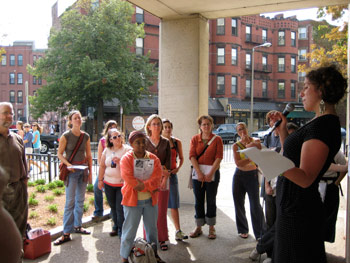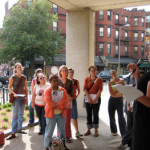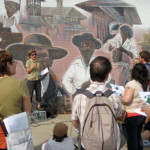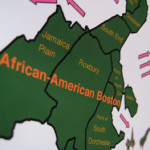By MATTHEW NASH
On the corner of Westland and Mass. Ave, across from the Christian Science Church, Andi Sutton stands on a milk crate in front of a small crowd. She is describing her project, “Crosspollination," and its relationship to race, class and the #1 bus route.
Sutton is the first of two presenters on this Saturday, as part of the Platform2 series of art and social engagement events that occur regularly in Boston. Platform2 is comprised of Kanarinka and Pirun from iKatun, Jane D. Marsching and Sutton – and presenters have included a wide array of professors, social scientists, and others who engage with art in the public sphere[1]. Platform2 events are described by their creators as "a forum for imaginative dialog about creative practice and its intersection with social, political, economic, and cultural issues," and this event is the third in the series.
As Sutton describes her “Crosspollination" interventions, Platform2 members pass out maps and diagrams that accent her story. A former curator at The Berwick Research Institute, and a resident of Cambridge, Sutton frequently took the #1 bus across town. This route passes through some of the starkest race and class lines in the two cities, beginning in Harvard Square, passing through Central Square and MIT before crossing the river near Newbury Street. It continues past the Christian Science Church and Symphony Hall before entering the South End, ultimately turning at Melnea Cass Boulevard and ending its run in Dudley Square. The glaring differences between Harvard Square and Dudley Square inspired Sutton to explore this bus route as a site where she might engage with the public.
Her project was meant to inspire conversation, and engage with people in unexpected ways. In order to start the dialogue, she transported heavy suitcases along Mass. Ave. and, if anyone commented or offered to assist, she began a conversation with them. Each interaction ended with Sutton giving a squash seed, wrapped in a hand-made paper pot, as a gift. Her intention is that each person will plant the seed, caring for it will remind them of their interaction with Sutton.[2]
While it might be easy to write this off as a mere game with no consequences, Sutton is pursuing larger goals. At one point she refers to her project as “social performance art as a data-gathering method" and expounds on what kind of “personal data and social data" can be extracted from a small, unplanned interaction. Some of her results, it seems, are the stories she has to tell. Others may take more time to understand. “I’m an artist, not a researcher. So what are the symbolic questions that I can use to gather data?" she asks at one point. “How does my subjectivity as an artist offset the post-performance evaluation?"
As the gathered crowd begins to consider these questions, a Platform2 member motions to the group, and we all move toward the bus stop. Not content with describing the #1 bus route and its vastly differing neighborhoods, Platform2 has planned to show us. As we file onto the bus, it’s clear that some in the group are more comfortable than others with public transit, and as some people make small talk, many look out the window and wonder what it was like for Sutton to carry her heavy cases along this route, hoping to meet new people. How many of the folks along the sidewalk are growing their own seeds at home, their lives altered in some tiny way by meeting Sutton?
In Dudley Square, Marie Cieri climbs atop the milk crate in front of a mural facing Malcolm X Boulevard as the Platform2 team hand out a sheet with two maps. Cieri asks us to look closely at the first map, which shows all of the neighborhoods of Boston in green on a white background. The center section, including parts of Charlestown, Downtown and the Back Bay are all circled with the label “Boston." Cieri points out that this is what one would generally find if they were to buy a map of Boston. The remaining parts, outside the circle, are each labeled “Also Boston" and “Yes, Also Boston."
As an assistant professor of social geography and critical cartography at Ohio State University, Cieri has spent a lot of time considering social spaces and our perception of them. Her work has led her to a variety of urban centers and rural townships, including Boston. Her second map depicts a tiny piece of her research, and is labeled “African-American Boston." For this project, Cieri spoke with a number of people who identify themselves as African-American, and asked them questions about where they go, where they feel comfortable, and places they avoid. Her map shows the neighborhoods in which African-Americans feel at home, with neighborhoods that they avoid spinning off from the center. The further a neighborhood from the center, the less likely her subjects were to go there. Unsurprisingly, South Boston is furthest away, jammed into a corner of the page.
For her talk, Cieri reads us excerpts from the stories she has collected. They illustrate the idea that some perceptions are perpetuated by oral history, while others are based in more concrete facts. As if to drive her point home, a passerby in a car asks one of the audience members “Don’t you know where you are?" – implying that Dudley Square is not a safe place for white folks, even on a sunny Saturday afternoon.
Cieri asks us to take a few minutes to explore Dudley Square, which has seen much growth and development in the past few years. For many in the group, Dudley Square is not a place they ever visit. For others who regularly stop in to The Berwick, it is more familiar. The conversation seems to hover around some uncomfortable middle ground, as those who remember Dudley a decade ago are awed at the improvements, and at the same time aware of the restrictions of class and poverty that keep the area from truly flourishing.
The event winds down with another bus trip to the studio of Jane D. Marsching, where Sutton and Cieri each conclude their presentations and take questions. Sutton shares some of her stories from “Crosspollination" and Cieri offers more examples of how perceptions of site can influence behavior. When she notes that there are very few black geographers, I wonder aloud if there isn’t some correlation between the places people feel comfortable going and the types of careers they feel comfortable pursuing. Others chime in on the various topics that have inspired them, leading to an extended discussion about how race is perceived and the ways in which class is constructed.
Platform2 events are designed to inspire dialogue, and each presentation topic offers a rich depth of possibilities. Often there are no concrete results to be seen from a day of discourse, but the importance of these meetings and the areas in which they explore the overlap between art and social activism are necessary and vital in Boston today. More events are planned for the near future, with a range of topics and events. For anyone interested in art and social engagement, Platform2 events are the perfect way to spend a day and leave you with much to consider.
- Andi Sutton talks about her project Crosspollination
- Marie Cieri, discussing African-American Boston in front of a mural in Dudley Square.
- Marie Cieri, African-American Boston, map, 2007.
----
[1] - A previous Platform2 event, featuring elin o'Hara Slavick, resulted in the piece "45 Questions About Art & Activism" in issue #61.
[2] - Those familiar with other projects by Andi Sutton will note that the use of vegetation as a medium for conversation is a recurring theme in her work. Most notably, as one of the primary members of The National Bitter Melon Council, Sutton was involved in this large-scale use of a vegetable to engage with an entire neighborhood and open up dialogue between communities through their relationship to an Asian vegetable.
"Risk: Race, Class, Geography, and Art" was hosted by Platform2 on Saturday, September 22, 2007 throughout Boston.
All images are courtesy of Platform2.
Images by the author.







